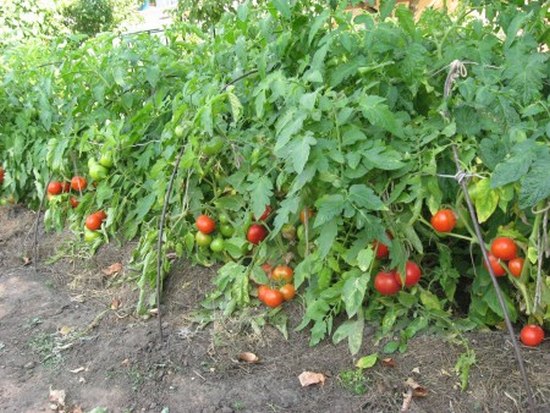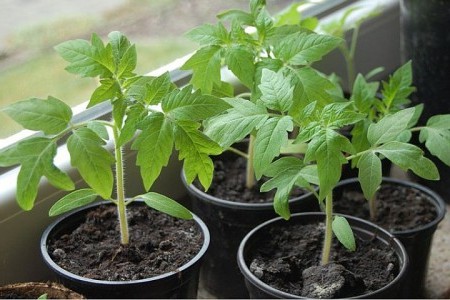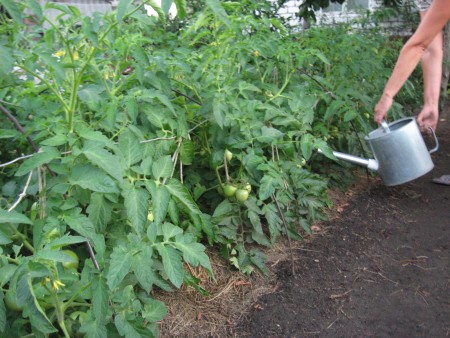What needs to be done to prevent tomatoes from getting sick and to grow strong and healthy? After all, you really want to grow delicious, healthy tomatoes in your own beds, and not buy them at the market!
|
The answer to this question can be formulated as follows: growing tomatoes correctly means strictly following agricultural techniques, creating favorable conditions for the development of strong, productive plants and unfavorable conditions for pests and pathogens. |
But in order to follow agricultural technology, you need to know it.
Select your seeds carefully
To grow good tomato crops, you need to start by selecting resistant varieties. Vegetable growers have recently increasingly given preference to domestic varieties, which are created taking into account our soil, climatic and phytosanitary conditions. For example, scientists from the All-Russian Research Institute of Irrigated Vegetable and Melon Growing (Astrakhan) recommend the following varieties:
- Ranovik
- Chizhik
- Record holder
- Forward
- Royal
- Gigantella
- Cleopatra
- New Prince
- Orange avyuri
- Astrakhansky 5/25
These varieties are distinguished (of course, to varying degrees) by resistance to blossom end rot, cracking, dry growing conditions, viral and fungal diseases. Many gardeners give preference to foreign varieties - this is not entirely correct. Scientists emphasize that foreign-bred varieties are inferior to domestic ones in terms of taste, resistance to many diseases, and yield.
You can grow tomatoes from your own seeds
For those who grow tomatoes from their own seeds, scientists recommend:
Firstly, harvest them only from ripe fruits collected from healthy plants.
Secondly, be sure to ferment the seeds in the pulp for 2-3 days.
For sowing, it is better to use not fresh, but 2-3-year-old seeds, which are freed from pathogens during storage. Pre-sowing treatment in solutions of biological preparations: phytosporin-M also helps to reduce seed contamination. Alirin-B, gamair. The same preparations are used to treat plants during the growing season.
Educational video on how to prepare and sow tomato seeds:
Properly grow tomato seedlings
Early sowing does not guarantee success
The health of tomatoes largely depends on the conditions of the seedling period. Often, summer residents try to sow seeds for seedlings as early as possible, reasoning something like this: the earlier we sow, the earlier we will get the harvest. The plants of such hasty gardeners do not grow, but suffer. More often Tomato seedlings are not grown correctly! In February, the roots of seedlings freeze on cold window sills, and the leaves suffer from the flow of dry air coming from the heating radiators.
Let's add to these costs of early sowing a lack of light, excessive watering, nitrogen fertilizing, which, according to adherents of early sowing, should stimulate the growth of seedlings, and we get a full set of conditions that negatively affect the development of seedlings.
By the time of planting in open ground, summer residents have thin, long plants with elongated internodes. Such seedlings, being planted in a garden bed (especially without preliminary hardening in the fresh air), take a long time and are difficult to take root. Some of them die completely, being scorched by the sun and battered by the wind.
The leap in time that early sowing should have given the seedlings is negated by a period of difficult and long adaptation to new conditions. Not having time to survive the stress of transplantation, young tomatoes are often forced to suffer again: sharp changes in night and day temperatures, and sudden heat weaken the tomatoes even more. Frail immunity fails, and plants cannot resist infection (viral, mycoplasma, bacterial), they get sick and even die.
In a word, chasing the early harvest of tomatoes, summer residents often lose the entire harvest.
Seedlings sown later (mid-March - early April) develop under increasing daylight conditions. It becomes possible to ventilate the room more often without risking the health of the plants and even take the seedlings out into the fresh air.
As a result, stocky, healthy seedlings are planted in the garden bed, which tolerate replanting painlessly and almost immediately begin to grow in a new place.
It only takes a little help, for example, spraying it with zircon or HB-101, so that it can resist diseases. Of course, such plants can get sick, but, as a rule, if agricultural practices are followed, the disease does not become widespread. By removing the affected bushes, gardeners stop the spread of infection. Such sanitary culling has little effect on the overall yield.
It is even more correct to grow tomato seedlings not on window sills, but in temporary film shelters and warm beds. Dry tomato seeds can be sown in such garden nurseries as soon as the soil allows. Tomatoes will sprout when favorable conditions for germination are created. Germinated seeds are sown only after the soil in the greenhouse has warmed up. Before sowing, the emerging weeds are weeded out.
If there are a lot of seeds (supplied from your garden), you can carry out a combined sowing - dry and germinated seeds. In warm weather, both will emerge with a short interval in time. A sharp cold snap can destroy germinated seeds, but dry ones, albeit with a delay, will sprout. Tomatoes sown directly into the garden grow more viable. But this method requires a large number of seeds.
Watch an interesting video about how you can start growing tomatoes in March by sowing seeds directly into the ground:
How to grow a good harvest of tomatoes
When a tomato is not happy with a tomato.
Properly growing tomatoes means, first of all, observing crop rotation. It’s difficult to do this in the country, even more difficult in a greenhouse, but you can’t do it without it. Tomatoes can be grown after many vegetable crops, but it is strictly not recommended to place them after related crops of the nightshade family: peppers, eggplants, potatoes.
It is undesirable to grow tomatoes after cucumbers, due to the development of viral diseases that can be common in both tomatoes and cucumbers. Continuous cultivation in one place is even more harmful to the health of tomatoes. Crop rotation is very important; without this agricultural technique, you can forget about good tomato harvests.
Failure to observe crop rotation contributes to the accumulation of pests (for example, cotton bollworm) and pathogens. Even if you annually replenish the plot with organic and mineral fertilizers, tomatoes will steadily reduce their yield.
According to the rules, tomatoes (and other nightshades) are returned to their original place after five years. In small summer cottages it is difficult to maintain such a gap, but it can be reduced by introduction of green manure into crop rotation.
Tomatoes planted where nightshades grew last year can develop quite normally, but during the period of mass ripening of the fruits, their leaves begin to quickly dry out. Plants do not realize their potential yield.
How to properly feed tomatoes
Equally important for the health of tomatoes is balanced diet. Rasthenia, which receive everything they need, acquire immunity to diseases and pests.
Potassium is of particular importance for tomatoes.By promoting the thickening of cell walls, this microelement thereby prevents their infection.
The reduced resistance of tomatoes to diseases in summer cottages can often be explained by the enthusiasm for nitrogen fertilizing. After applying urea, the bushes are transformed and grow noticeably, which cannot but please summer residents. And behind the external positive effect, they cannot consider the negative effect of nitrogen on plants.
By enhancing cell growth, nitrogen contributes to the thinning of their walls, and thereby reduces plant resistance to diseases and adverse weather conditions.
Microelements give tomato a certain resistance to diseases: manganese, zinc, copper, boron.
Taking all this into account, you should reconsider your attitude to fertilizing: abandon the indiscriminate use of urea, giving preference to complex fertilizers with microelements, potassium sulfate, and wood ash.
Tomatoes that are planted (or sown) without delay suffer less from diseases and pests. Tomatoes are usually planted in open ground in May or early June, focusing on the temperature of the air, soil, and the weather forecast for the coming week. Tomatoes are planted under temporary shelters two weeks earlier. By the time the pests multiply massively and the infection spreads widely, the plants will have time to grow, become stronger and will be able to produce a generous, good harvest of tomatoes.
Don't forget to water the tomatoes
Late watering reduces the resistance of tomatoes to diseases and pests. When there is a shortage of water, plant leaves wilt, nutrients begin to rapidly decompose in them, becoming easy food for pests. This is why aphids, mites, and thrips love to settle on weakened plants.
Timely watering relieves plants from such stress. Their frequency depends on the weather and soil structure. On light soils, water more often, but at lower rates than on heavy soils. Loosening and mulching between rows help conserve moisture in the soil.
It is better to water tomatoes in furrows or using a drip irrigation system rather than by sprinkling. The latter method promotes infection and intensive development of diseases.
Create favorable conditions for tomatoes
Not the least role in protecting tomato plants belongs to the environmental friendliness of the site. Summer residents attach little importance to this, relying more on pesticide treatments. It would seem that there is nothing easier than sowing nectar-bearing plants on the plot that attract entomophages - insect predators that destroy garden pests, but few summer residents use this.
Dill, basil, coriander, phacelia, savory, hyssop, lemon balm - this is not a complete list of plants on which entomophages feed. When sown next to tomatoes, these plants will help make the microclimate of even a single garden more favorable, and you will not need to resort to chemical protection.
If you still cannot do without spraying, experts advise turning to the help of biological preparations.
To reduce the number of pests (cotton bollworm, thrip owls, mites, aphids, etc.), it is better to treat tomatoes several times with lepidocide, bitoxybacillin, phytoverm than once with a chemical insecticide. The main thing is not to wait for mass reproduction of pests. And the fewer pests in the garden, the greater the chance that the tomato bushes will not be infected with viruses and the fruits will not be damaged cutworm caterpillars, and you will grow a good harvest of tasty tomatoes.
And here is a video about how tomatoes grow in the right bed:
Continuation of the topic:
- How to grow Oxheart tomatoes correctly
- The best varieties of pink tomatoes
- Growing tall tomatoes in summer cottages
- Biological products to protect the garden from pests
- What's the best way to control weeds?
- Preparing fertilizers for various vegetables
- How to protect tomatoes from late blight
- Growing tomatoes in open ground from A to Z
- Caring for tomatoes in a greenhouse from planting seedlings to harvesting




 (30 ratings, average: 4,53 out of 5)
(30 ratings, average: 4,53 out of 5) CUCUMBERS NEVER GET SICK, I'VE BEEN USING ONLY THIS FOR 40 YEARS! I SHARE A SECRET WITH YOU, CUCUMBERS ARE LIKE THE PICTURE!
CUCUMBERS NEVER GET SICK, I'VE BEEN USING ONLY THIS FOR 40 YEARS! I SHARE A SECRET WITH YOU, CUCUMBERS ARE LIKE THE PICTURE! You can dig a bucket of potatoes from each bush. Do you think these are fairy tales? Watch the video
You can dig a bucket of potatoes from each bush. Do you think these are fairy tales? Watch the video
 How our fellow gardeners work in Korea. There is a lot to learn and just fun to watch.
How our fellow gardeners work in Korea. There is a lot to learn and just fun to watch. Eye trainer. The author claims that with daily viewing, vision is restored. They don't charge money for views.
Eye trainer. The author claims that with daily viewing, vision is restored. They don't charge money for views. A 3-ingredient cake recipe in 30 minutes is better than Napoleon. Simple and very tasty.
A 3-ingredient cake recipe in 30 minutes is better than Napoleon. Simple and very tasty. Therapeutic exercises for cervical osteochondrosis. A complete set of exercises.
Therapeutic exercises for cervical osteochondrosis. A complete set of exercises. Which indoor plants match your zodiac sign?
Which indoor plants match your zodiac sign? What about them? Excursion to German dachas.
What about them? Excursion to German dachas.
I always grow tomatoes from freshly harvested seeds and they always grow beautifully. They came up with a wait of 3 years.
It seems to me that I grow the strongest and healthiest tomatoes when I sow the seeds directly into the ground. Of course, they begin to bear fruit a little later, but they get sick less, and the yield is higher.
Irina, the seedless method of growing tomatoes is justified only in the south. To the north of Moscow, even seedling tomatoes do not have time to properly ripen. What kind of sowing in the ground is there?